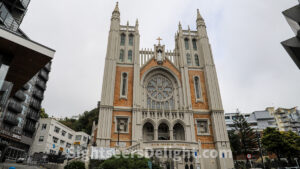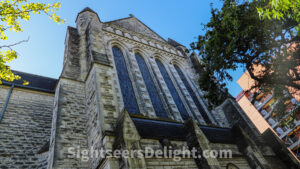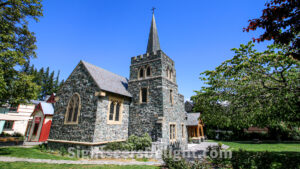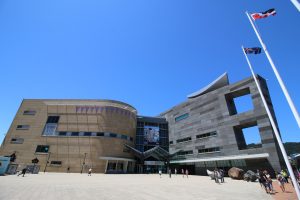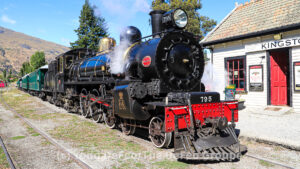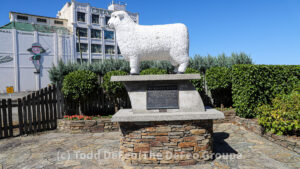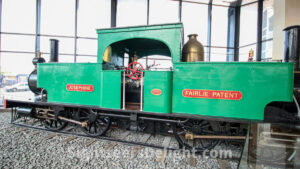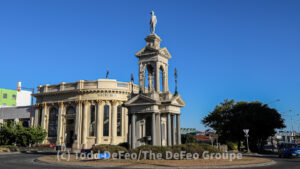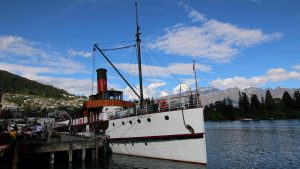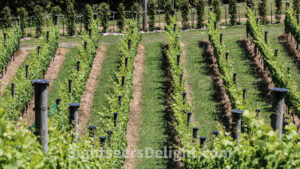St. Mary of the Angels sits on the site of Wellington’s first Catholic Church, established in 1843, and is the third church to occupy the site. The church opened on March 26, 1922, replacing a building that burned in May 1918. Construction started in April 1919, and the church’s contractor, H.E. Manning, went bankrupt during construction. Father Stanislaw Mahoney, the parish priest, and a close friend, Martin Maloney, worked with a group of largely unskilled workers to complete the church.
St. Peter’s was designed by an architect from Dunedin using Gothic details, but built along the lines of an English parish church. Anglican roots in Queenstown, however, date to at least 1861. An earlier church was built in 1863 and modified over the years. The oft-photographed stone church, which almost seems out of place in adreneline-driven modern Queenstown, seats 130 people.
New Zealand’s national museum, Te Papa Tongarewa, opened in 1998 on Wellington’s waterfront. The museum, a celebration of New Zealand’s identity – the people, culture and environment, features hi-tech and traditional displays. As well as significant collections of New Zealand art, the 16,000-plus taonga / treasures looked after by Te Papa are the largest Māori collection in any museum and cover a broad spectrum of Māori art and culture, from revered and significant cultural heirlooms through to humble everyday items dating from early pre-European times to today. In 2017, the museum was named as one of the top 25 museums in the world by TripAdvisor – the only museum in Australasia to be included.
The Southern Provinces Romney Breeders Club erected The Romney Statue in Gore, New Zealand, in recognition of the importance of the sheep bred to the country’s meat and wool industry. K.A. Bain, president of the New Zealand Romney Sheep Breeders Association, unveiled the statue on July 2, 1991. Messrs. Bennett and Young first imported the Romney sheep to New Zealand, reaching Wellington in 1843. New Zealand Romney sheep comprise more than half of New Zealand’s 40 million sheep.
The Toitū Otago Settlers Museum, New Zealand’s oldest history museum, focuses on the early settlers to the Dunedin region. The Otago Early Settlers’ Association first founded in 1898, and the earliest iteration of the museum opened in 1908. The current iteration of the museum opened in 2012. It features 14 themed galleries with interactive displays telling the stories from the earliest settlers to more recent arrivals.
The Troopers Memorial in Invercargill, New Zealand, is a tribute to Southland’s soldiers who served in the Boer War. Unveiled in 1908, it honors 24 local soldiers who died in the conflict, keeping their memory alive for new generations. The memorial, designed by Dunedin architect Newton Vane, includes a trooper statue and detailed design features. It is made from durable materials such as Aberdeen granite.
The TSS Earnslaw, a 1912 Edwardian vintage twin-screw steamer, plies the waters of Lake Wakatipu in and around Queenstown. The vessel launched on Feb. 24, 1912, and formerly served New Zealand Railways (NZR), earning the nickname the “Lady of the Lake.” The steamer is said to be the only remaining commercial passenger-carrying coal-fired steamship in the southern hemisphere. Today, the Earnslaw carries tourist passengers across Lake Wakatipu from Queenstown to Walter Peak High Country Farm. During the 1.5-hour cruise, travelers can view the steam engine and watch stokers feed coal.
Waiheke Island is a short and scenic 40-minute ferry ride from Auckland’s central business district. Upon arrival, the picturesque wine-lovers’ paradise feels like a world away. Surrounded by the waters of Auckland’s Hauraki Gulf Marine Park, Waiheke Island has been a long-time haven for free spirits, artists and Auckland families on beach holidays. In more recent times Waiheke’s relaxed joys have also earned international appreciation. Waiheke is the favorite island get-away for Aucklanders attracted by beautiful white sandy beaches and historic sites, a thriving food scene, an eclectic mix of artists, an extensive list of boutique and luxury accommodation, brazen architectural delights and some of New Zealand’s most coveted vineyards and wineries. Waiheke Island is New Zealand’s third-most populated island with a permanent population of around 9,000.
Based on content courtesy of Tourism New Zealand.

